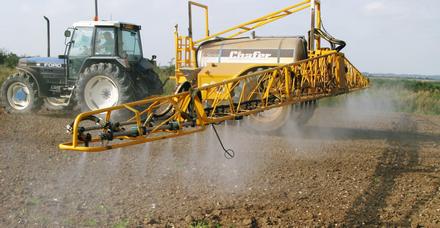Case for pre-emergence treatment strengthens

Why are pre-ems increasingly important in winter wheat and barley?
Good blackgrass control, especially in barley, is well nigh impossible without pre-ems, warns Mrs Bend. They are also valuable tools in delaying Atlantis resistance, increasingly noticeable at one of the firm’s trials sites, where control has “plummeted” from 100% to 95.5% in only three seasons.
Mr Neale agrees they are key in barley because post-em options against blackgrass are so limited. Many broadleaved weeds now showing reduced sensitivity to post-em applications are effectively controlled by Ice or Liberator, he adds.
With post-em options running into higher levels of resistance and providing inconsistent results unless the weather is favourable, pre-ems are growing in importance, says Dr Ellerton.
They allow post-em spray timings to be more flexible, add to their residual components and at low rates will assume an even greater role in tackling annual meadowgrass after IPU has gone.
Pre-ems are extra significant now that the maximum dose of IPU is 3litres/ha, says Mr Abel. In barley they are “crucial”.
| PRE-EM TIPS |
|---|
|
Should drilling ever be interrupted to apply pre-ems?
Yes, if possible, says Mr Abel. “A pre-em is the building block of any good programme, and without it control and profitability will be compromised.”
Mrs Bend and Dr Ellerton agree, especially to allow fields with severe grassweed problems or with known resistance or signs of it to be treated.
Varieties less competitive with blackgrass, like Hereward, should get priority, suggests Mrs Bend. Others, with more aggressive growth habit, like Oakley, can deliver a degree of free “control”. But if soils are very dry better control can come by waiting until peri-emergence when blackgrass is just spearing through.
Delaying drilling to go spraying can permit better blackgrass germination as it allows stale seed-beds to be left longer, she adds.
“I believe weed control is becoming more important than early drilling on some fields since failure to control grassweeds, especially resistant ones, can cause problems for many years,” says Dr Ellerton.
If growers cannot find time to catch up with spraying to ensure treatments are applied pre-emergence for maximum effect, Mr Neale suggests they consider using a contractor. “The cost is far outweighed by the return from good grassweed control.”
What factors need taking into account when choosing which products to apply? The Agronomists
Clare Bend Masstock Arable
Gerald Abel Farmacy
Dave Ellerton ProCam
Dick Neale Hutchinsons
Seed-bed quality, drilling depth, the weather, previous product use and control results, target weeds and their resistance status all need considering, say our four commentators.
More specifically Dr Ellerton notes that at current grain prices there is more leeway to choose the best appropriate products. Previous problems have tended to be linked to “cheap and cheerful” approaches such as straight trifluralin or very low rates of Crystal or Liberator.
Mr Neale urges growers to try all products, and especially to think about switching from pendimethalin if it has given poor control. “Grassweed populations are individual to a farm and how they have been treated,” he says. “Growers must assess products on their own populations.”
Mr Abel believes the aim of product selection should be to maximise the number of different modes of action within the programme.
Mrs Bend also urges chemistry rotation. “And if the blackgrass infestation is bad, go for the best.”
What are the various options, their key strengths and weaknesses and relative costs?
Costs vary from £5 to £35/ha, says Mr Neale. “But £5 won’t get you very far in a high population of two-star resistant
Active Ingredients |
|---|
Atlantis iodosulfuron-methyl- sodium + mesosulfuron-methyl Crystal/Ice Defy prosulfocarb IPU isoproturon Liberator diflufenican + flufenacet Roundup Max glyphosate Sumimax/Guillotine flumioxazin |
Dr Ellerton regards Crystal, Liberator and Defy as the main choices. “These are all strong on a range of grassweeds although Defy must be mixed with another product.” Costs are similar though Crystal is slightly more expensive.
“Defy has shown exceptional control of ryegrass this year and is slightly safer in hallow–drilled situations,” he adds.
Mrs Bend says Crystal performs well but is becoming less popular due to its high rate of use and sprayer staining and should be avoided on fields which have had repeated pendimethalin applications over the years.
Limited data suggestDefy in mixtures is the best product on brome, she says.
“It’s one to consider if lots of flufenacet-based treatments have been used over the years, but it does need the trifluralin addition.”
Adding trifluralin to Liberator, Crystal or Defy generally delivers an extra 20% control over the products used straight, and is a “must” for bad blackgrass fields.
Mr Neale notes that Defy is highly reliant on its partner for good effect. “With trifluralin at high risk of revocation a new partner will need to be found for sustained blackgrass control.”
In difficult seed-beds and where there is a risk of heavy rain after application, Defy in a tank mix is “a very good fit and kind to the crop,” says Mr Abel.
“Where seed–beds are better and the seed is a minimum of 3.2mm deep, Liberator or Ice in a mix with trifluralin has been working very well. However, I am concerned about the long-term over-reliance on flufenecet-based products.
“After seeing Defy produce good results against the industry standards in a difficult population of blackgrass last year, I shall be increasing its useage this autumn if it is competitively priced.”
Flumioxazin, new this autumn and to be sold under several names, is outstanding on broadleaved weeds with good grassweed activity if correctly timed, says Mr Neale.
Mrs Bend agrees that in Guillotine it is an “interesting new active” but notes that it is approved for wheat only.
“It looks quite useful,” says Dr Ellerton. However it has some crop safety issues particularly applied post-emergence and looks quite expensive, he adds.


